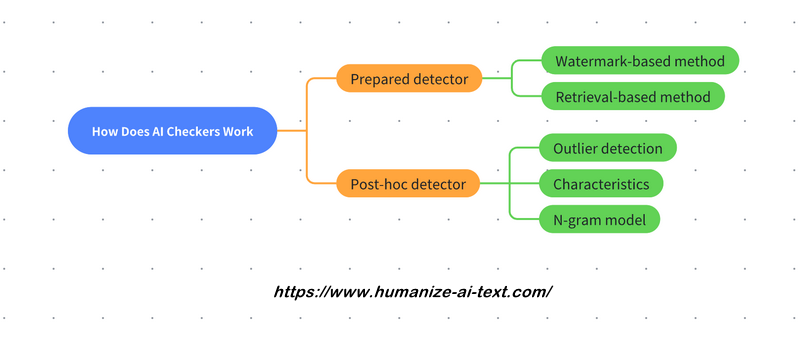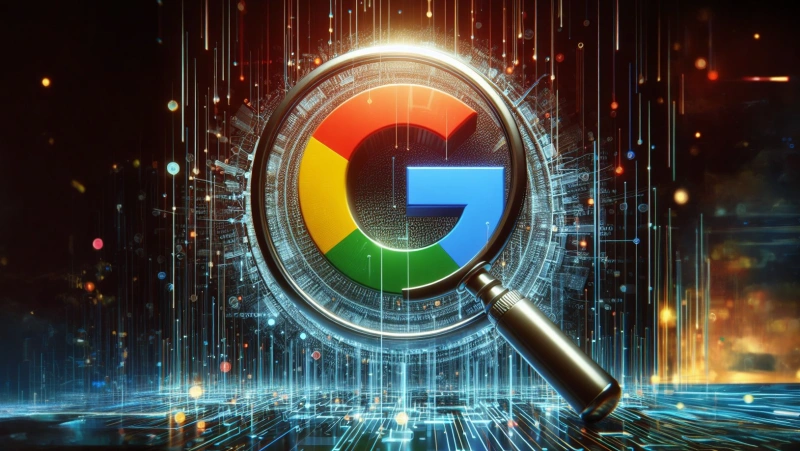How Does AI Checker Work: Methods and Accuracy
Updated on: April 26, 2024
Written by: Anthony
AI is getting better and better, which is really helping with writing. The OpenAI's ChatGPT (especially GPT-4.0) is getting really good at making writing that looks and feels like it was written by a real person. It's so good that sometimes it's hard to tell the difference! This kind of AI is being used to write all sorts of things like news stories, posts for social media, and even school papers.

However, there are worries about the wrong use of Large Language Models (LLMs). The fears include spreading wrong info, creating fake news, and academic plagiarism. To handle these challenges, we need to understand how to check content made by artificial intelligence, or AIGC. This article will explain how an AI checker works and how precise it is.
Table of contents
How Do AI Checkers Work?
Generally speaking, detecting AI content can be done in two main ways: Prepared detectors and Post-hoc detectors. Prepared detectors adjust large models during training to recognize AI-generated content. They use methods like watermarks and retrieval. Post-hoc detectors modify trained models to identify AI-generated text. It includes zero-shot detection (without needing a dataset) and finetuning-based detectors (needing a dataset).

1. Prepared detector
a. Watermark-based method
During training, add marked text to the model and check if the output text includes the mark. If it does, it's AI-generated. And there are two types of marks: biased sampler and pseudo-random:
- A biased sampler adjusts the model's output distribution over words.
- Pseudo-random doesn't change output probabilities but tweaks the output text.
b. Retrieval-based method
Users interact with AI first to get AI content. And then compare new texts with these contents. If they're similar, it's likely AI-generated. However, this method may raise privacy concerns as it requires storing user data.
2. Post-hoc detector
- Outlier Detection: AI tends to generate texts with higher probabilities, which are often common texts. If a text consists mostly of very common words, and each word has a high probability of occurrence, then it is very likely that this text was generated by AI.
- Characteristics: Considering the characteristics of AI responses, which are not good at logical inference but excel at rote memorization. Based on this point, we can judge whether the text is generated by AI.
- N-gram model: The same LLM (Large Language Model) is more likely to generate similar texts. So we can give the model a prompt and let it generate some contents multiple times, and then compare the similarity of these contents. If they are all very similar, then these outputs are probably generated by AI.
To break it down, AI checkers don't just focus on certain words or sentence structures. Instead, they learn from huge amounts of text using machine-learning techniques. They look at the whole content rather than just individual words. AI checkers are smart and rely on a lot of data. They use big data and algorithms to learn text features automatically instead of needing specific rules set by people. This lets them better deal with text that has complicated meanings and makes their detection highly accurate.
How accurate are AI checkers or detectors?
Although accurately detecting AI-generated texts can prevent the misuse of AI-generated content and combat the spread of fake news and misleading information, at present, accurately detecting AI content remains quite challenging. Although there are various AI text checkers available on the market now, they still face challenges in terms of accuracy and reliability.
For example, different AI checkers use different methods and standards, which may result in differences in detection results. The type, style, and domain of the text may affect the accuracy of detection. For example, technical or scientific texts may be misclassified as AI-generated due to their specific language style. Especially when the text is co-authored by humans and AI, it becomes even more difficult to accurately distinguish between them.
So how accurate is an AI checker? The answer is quite limited overall. Especially with these checkers that rely on a single detection method. If you want to improve the accuracy of an AI checker, it's necessary to understand the limitations of the tool, use multiple tools together, and integrate human judgment and review when necessary, which is currently the best practice.
The best AI checkers or detectors
1. Originality.ai
Originality.ai is a leading tool known for simplifying content detection and ensuring reliability. Users favor it for accurately identifying AI-generated content, thereby maintaining the authenticity and originality of written material. Originality.ai stands out for its distinctiveness as a Google Chrome extension, enabling real-time checks to determine if a webpage was created by AI. Its combination of speed and reliability makes it a trusted ally in preserving content integrity.
2. GPTZero
GPTZero is a tool made for teachers and schools. It helps to check if students' work is original. It's simple to use, but it might not have all the features some people want. However, it works well with programs like Microsoft Word and online learning platforms. This makes it easier for teachers to check students' work and give grades. It saves teachers time because they don't have to check everything manually. Plus, it can be customized to fit different needs.
3. Copyleaks
Copyleaks has an easy-to-use tool on their website that finds AI-created content. It's helpful for students and writers. They also made a tool for Google Chrome that spots AI content when you're browsing online. Copyleaks works with big educational systems to bring this tool into schools, making sure assignments are honest. They even have tools to help teachers grade fairly. In short, Copyleaks helps keep schoolwork honest and makes it easier for teachers to grade.
4. Writer.com
Writer is a helpful tool for writers. It suggests corrections for grammar, advises on tone, checks for plagiarism, and more. It also has a special feature that spots content made by AI. To use it, you can paste your text or share a webpage link. Then, when you click "Analyze Text," it tells you how much of your content was likely created by AI. The Writer has a simple scanner on its website for free. But for the full AI content detection, you need to use its API. It's mainly for big businesses and can adapt to your brand's style and data.
5. Contentatscale.ai
Content at Scale is a special tool that helps with writing using AI. It has something called an AI detector. This tool checks if the content is made by AI and helps make it sound more like it was written by a human. It gives a result very quickly after you put in the content. Unlike other tools, it also gives a score for how much the content seems human. This score looks at things like how likely it is to be AI and if it follows a pattern. This tool gives more details about why it thinks the content is AI-made, making it a good choice for checking content.
Can Google Detect AI-Generated Content?
Google has acknowledged its ability to detect AI-generated content and warns against it. The famous "Helpful Content Update" has a big strike on spam websites, whose content is generated by AI, leading to a huge traffic drop. According to Google's staff, the scraping content, even with modifications, violates Google's spam policy. Google employs multiple algorithms to combat such behaviors and demote sites with AI generated content.

However, the good news is that although Google has gotten better at detecting content made by AI, it's not perfect. Google's latest algorithms need to depend on various signals to detect AI-generated content. And it gets harder with the development of AI technology. Besides, Google claims that not all AI-generated content will be penalized. AI-generated content is not equal to spammy content. Google will only fight against content that is scraped or AI-generated in a spammy manner.
How to bypass AI checkers or detectors?
Of course, besides the current studies on detecting AI-generated text, at the same time, there are also studies on bypassing AI detection. If you're a student using AI to help with answering questions and writing papers, you might need to avoid detection by your school; Or if you're an SEO content writer using AI to create content, you might need to bypass detection by search engines like Google. In these situations, you might need to bypass AI checkers or detectors. No worries, we will help you out.
Just three simple steps are all it takes to rewrite your AI-generated texts into human language, effectively bypassing AI checkers.
- Open the AI text humanizer tool;
- Input or directly copy and paste the text into the text box, then click the "Humanize" button;
- Wait a moment, and your AI-generated texts will be successfully rewritten into human-written texts;

The advantage of this method is that it makes AI-generated text appear more natural and in line with human writing styles, reducing the likelihood of detection by AI checkers. With this approach, you can create content that seems to have been authored by a genuine human with ease, without worrying about being flagged.
Summary
Now that you understand the principles and methods of AI detection tools for text and their accuracy. In addition, we've also provided detailed introductions to some useful AI detection tools in this article. Most importantly, we've taught you how to quickly bypass AI checkers or detectors. We hope this article has been helpful to you. If you have any further questions, feel free to contact us.